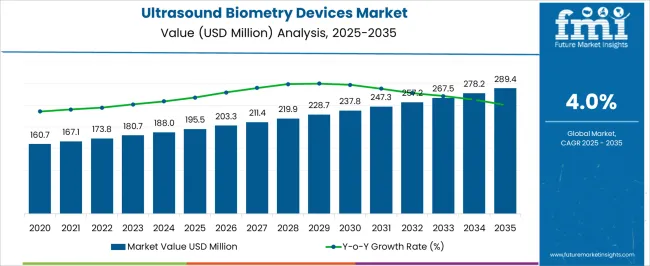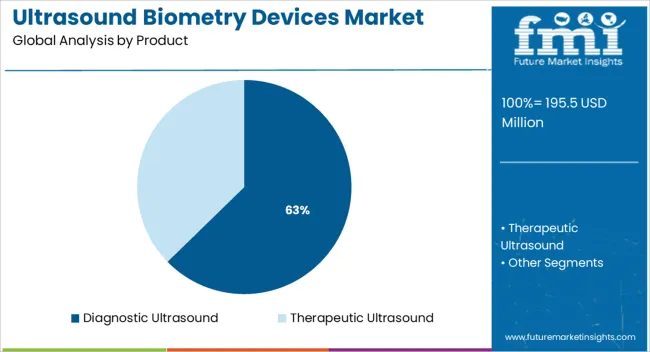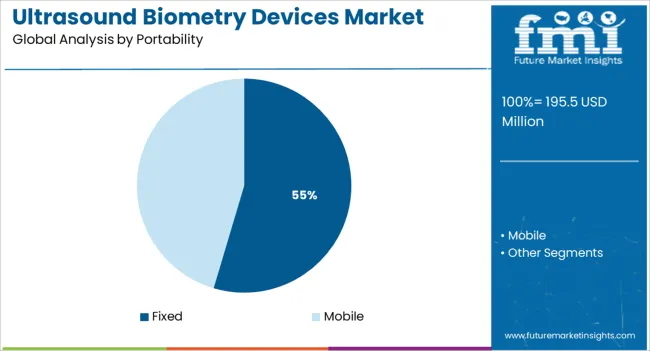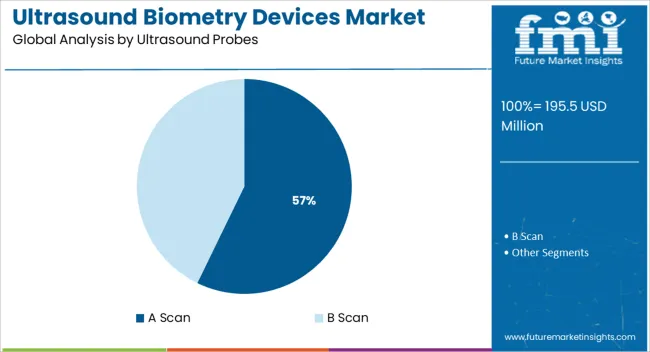The Ultrasound Biometry Devices Market is estimated to be valued at USD 195.5 million in 2025 and is projected to reach USD 289.4 million by 2035, registering a compound annual growth rate (CAGR) of 4.0% over the forecast period.

| Metric | Value |
|---|---|
| Ultrasound Biometry Devices Market Estimated Value in (2025 E) | USD 195.5 million |
| Ultrasound Biometry Devices Market Forecast Value in (2035 F) | USD 289.4 million |
| Forecast CAGR (2025 to 2035) | 4.0% |
The ultrasound biometry devices market is experiencing steady expansion driven by increasing demand for noninvasive and real-time diagnostic imaging across ophthalmology, obstetrics, and general healthcare practices. Rising prevalence of age-related ocular disorders and fetal monitoring needs is prompting greater adoption of advanced ultrasound solutions.
Manufacturers are integrating AI-assisted imaging, improved resolution technologies, and multi-modal diagnostics to deliver accurate biometric data for both clinical and surgical planning. Healthcare facilities are prioritizing faster diagnostic turnaround and reduced patient risk, leading to investments in high-frequency and application-specific biometry systems.
Additionally, efforts to streamline workflow efficiency, expand outpatient diagnostic capabilities, and comply with evolving clinical standards are fueling market penetration. Continued innovation in probe technology, platform integration with electronic health records, and strategic deployment across emerging healthcare infrastructures are expected to shape future growth opportunities, positioning the market for consistent long-term advancement.
The market is segmented by Product, Portability, Ultrasound Probes, Application, and End User and region. By Product, the market is divided into Diagnostic Ultrasound and Therapeutic Ultrasound. In terms of Portability, the market is classified into Fixed and Mobile. Based on Ultrasound Probes, the market is segmented into A Scan and B Scan. By Application, the market is divided into Radiology, Gynecology, Cardiologic, Urological, and Others. By End User, the market is segmented into Hospitals, Diagnostic Centers, Maternity Centers, and Ambulatory Surgical Centers. Regionally, the market is classified into North America, Latin America, Western Europe, Eastern Europe, Balkan & Baltic Countries, Russia & Belarus, Central Asia, East Asia, South Asia & Pacific, and the Middle East & Africa.

The diagnostic ultrasound segment is expected to hold 62.7% of total revenue in 2025 under the product category, making it the most dominant offering. This share is being driven by the widespread clinical utility of diagnostic ultrasound systems in both ophthalmic and prenatal biometric assessments.
Diagnostic ultrasounds deliver high-resolution and noninvasive imaging that supports early detection, biometric tracking, and treatment planning with minimal patient discomfort. The integration of Doppler capabilities, enhanced transducer designs, and AI-powered image interpretation has further improved clinical accuracy and workflow productivity.
Hospitals and specialty clinics have prioritized diagnostic-grade systems that deliver consistent biometric precision across a broad range of patient demographics. As patient volume increases and imaging reimbursement structures continue to evolve, diagnostic ultrasound platforms are being favored for their scalability, imaging depth, and multi-probe compatibility, reinforcing their leadership within the product landscape.

Fixed ultrasound systems are projected to account for 54.6% of total revenue within the portability category in 2025, positioning them as the leading deployment model. This share is attributed to the integration of high-performance processing units, ergonomic console designs, and extensive probe compatibility that fixed platforms offer.
Clinical environments such as ophthalmic centers, hospitals, and diagnostic labs have continued to invest in fixed systems due to their superior imaging resolution, larger display interfaces, and ability to support multiple exam types within a single platform. Fixed ultrasound devices are often preferred for high-throughput settings where imaging precision and uninterrupted system uptime are prioritized.
Moreover, the availability of advanced software tools and continuous updates has allowed fixed units to maintain clinical relevance over longer operational cycles, reinforcing their prominence in permanent diagnostic setups.

The A scan segment is anticipated to contribute 57.2% of total revenue under the ultrasound probes category in 2025, establishing it as the leading probe type. This dominance is supported by the essential role A scan probes play in ophthalmic biometry, particularly in axial length measurement and intraocular lens calculation.
A scan probes offer linear and focused ultrasonic waveforms that deliver high precision in ocular structure analysis, which is critical in cataract surgery planning and ocular disease monitoring. Their compact form factor, quick calibration capability, and minimal learning curve have contributed to their broad clinical adoption.
Additionally, the integration of A scan probes into portable and fixed diagnostic platforms has extended their utility across outpatient and surgical settings. The growing demand for early-stage ophthalmic diagnostics and the rising global incidence of age-related vision conditions have further solidified A scan probes as the standard in biometric ultrasound applications.
The key factor driving the growth of the ultrasound biometry devices market is the rising prevalence of cataracts. Also, the increasing prevalence of chronic diseases among geriatric people is predicted to show robust growth during the projected period. Cataract surgical procedures provide significant improvements among the patients’ life. There has been a rise in the number of cataract surgeries among the population in the age range of 50-90 years.
Also, the increase in the patient’s preference for the minimally invasive process and diagnosis of life-threatening diseases is one of the factors that is propelling the growth of the ultrasound biometry devices market.
The ultrasound biometry devices market is primarily dominated by North America owing to a rise in splash out on healthcare, increasing upgraded lifestyles, and evolution in the clinical applications of focused ultrasound devices. Following, North America, Europe and East Asia are anticipated to show gradual growth in the ultrasound biometry devices market.
In European countries, a large number of clinical research projects in the field of ultrasound are taking place. This will boost the revenue growth of the ultrasound biometry devices market. Asia-Pacific may register as the rapid growing market because of the growing geriatric population, increasing awareness about developed technologies, and improving healthcare infrastructure.
Some of the key manufacturers operating in the ultrasound biometry devices industry are General Electric, Philips, Siemens, TOSHIBA, Hitachi Medical, Mindray, Sonosite (FUJIFILM), Esaote, Samsung Medison and Konica Minolta.
| Report Attributes | Details |
|---|---|
| Growth Rate | CAGR of 4.0% 2025 to 2035 |
| Base Year for Estimation | 2024 |
| Historical Data | 2012 to 2024 |
| Forecast Period | 2025 to 2035 |
| Qualitative Units | Revenue in USD Million, Volume in Units, and CAGR from 2025 to 2035 |
| Report Coverage | Revenue Forecast, Volume Forecast, Company Ranking, Competitive Landscape, Growth Factors, Trends and Pricing Analysis |
| Segment Covered | Product, Portability, Ultrasound Probes, Application, End User, Region |
| Region Covered | North America; Latin America; Europe; East Asia; South Asia; Oceania; Middle East & Africa |
| Key Countries Profiled | USA, Canada, Brazil, Mexico, Germany, UK, France, Spain, Italy, China, Japan, South Korea, Malaysia, Singapore, Australia, New Zealand, GCC, South Africa, Israel |
| Key Players | General Electric; Koninklijke Philips N.V.; Siemens; TOSHIBA Pvt. Ltd.; Hitachi Medical (Hitachi, Ltd.); Shenzhen Mindray Bio-Medical Electronics Co., Ltd.; Sonosite (FUJIFILM); Esaote Spa; SAMSUNG HEALTHCARE; Konica Minolta |
| Customization | Available Upon Request |
The global ultrasound biometry devices market is estimated to be valued at USD 195.5 million in 2025.
The market size for the ultrasound biometry devices market is projected to reach USD 289.4 million by 2035.
The ultrasound biometry devices market is expected to grow at a 4.0% CAGR between 2025 and 2035.
The key product types in ultrasound biometry devices market are diagnostic ultrasound and therapeutic ultrasound.
In terms of portability, fixed segment to command 54.6% share in the ultrasound biometry devices market in 2025.






Full Research Suite comprises of:
Market outlook & trends analysis
Interviews & case studies
Strategic recommendations
Vendor profiles & capabilities analysis
5-year forecasts
8 regions and 60+ country-level data splits
Market segment data splits
12 months of continuous data updates
DELIVERED AS:
PDF EXCEL ONLINE
Ultrasound Conductivity Gels Market Size and Share Forecast Outlook 2025 to 2035
Ultrasound Market Size and Share Forecast Outlook 2025 to 2035
Ultrasound-Guided Breast Biopsy Market Size and Share Forecast Outlook 2025 to 2035
Ultrasound Systems Market Growth – Trends & Forecast 2025-2035
Ultrasound Imaging Solution Market
Ultrasound Devices Market Size and Share Forecast Outlook 2025 to 2035
Ultrasound Skin Tightening Devices Market Size and Share Forecast Outlook 2025 to 2035
Teleultrasound Systems Market
Food Ultrasound Market Analysis – Applications & Innovations 2025 to 2035
Micro-Ultrasound Systems Market
Cardiac Ultrasound Systems Market - Trends & Forecast 2025 to 2035
Focused Ultrasound System Market Trends and Forecast 2025 to 2035
Handheld Ultrasound Scanner Market Size and Share Forecast Outlook 2025 to 2035
Portable Ultrasound Bladder Scanner Market Analysis - Size, Share, and Forecast Outlook 2025 to 2035
Wireless Ultrasound Scanner Market
Autonomous Ultrasound Guidance Market Analysis - Size, Share, and Forecast Outlook 2025 to 2035
Endoscopic Ultrasound Needles Market Size and Share Forecast Outlook 2025 to 2035
Veterinary Ultrasound Scanner Market Growth - Trends & Forecast 2025 to 2035
Anesthesia Ultrasound Systems Market Analysis – Trends & Forecast 2025 to 2035
Preclinical Ultrasound Systems Market Size and Share Forecast Outlook 2025 to 2035

Thank you!
You will receive an email from our Business Development Manager. Please be sure to check your SPAM/JUNK folder too.
Chat With
MaRIA